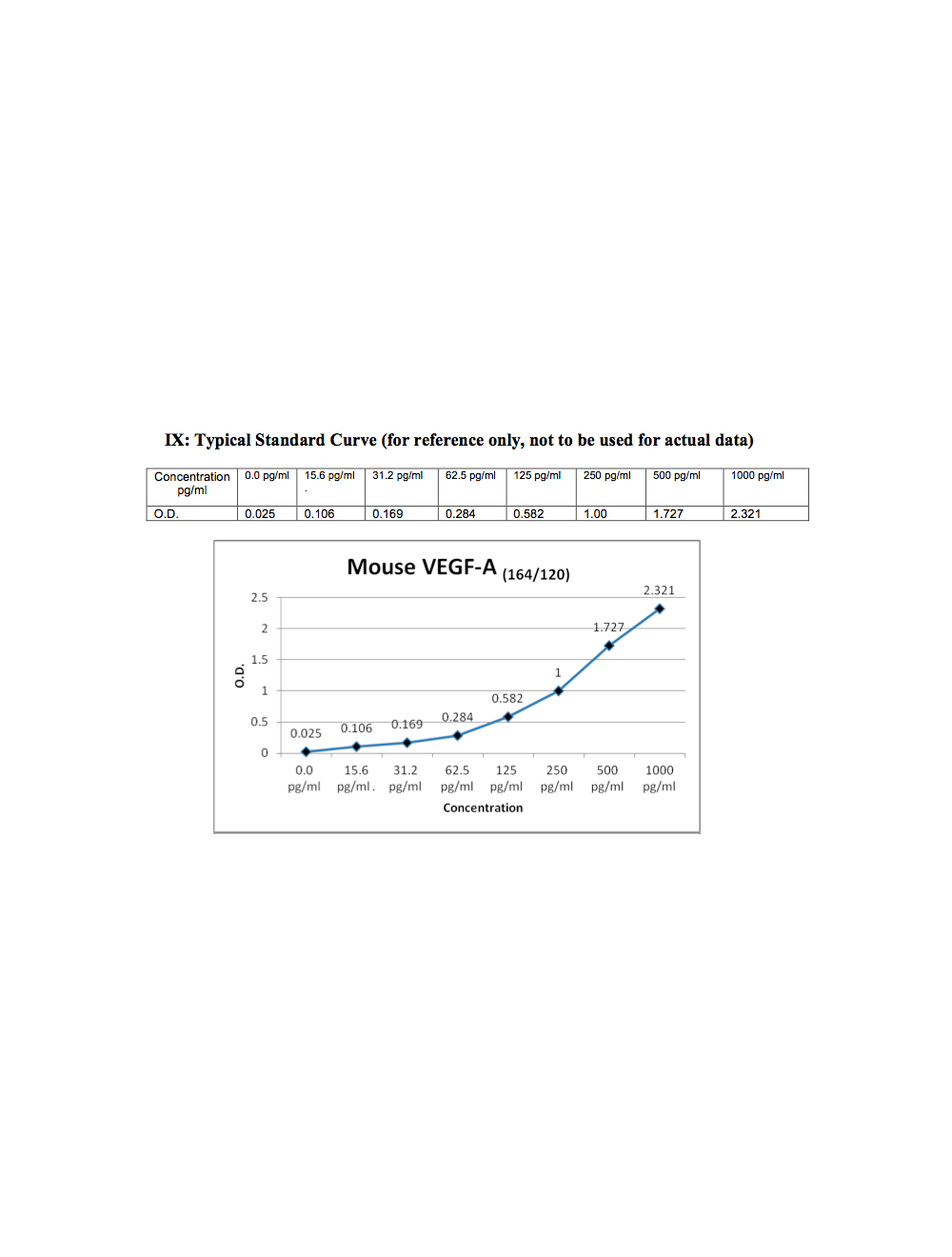Vascular endothelial growth factor A (VEGF-A), Mouse, ELISA assay
As low as
US$547.00
Only %1 left
Catalog Number
BEK-2110
- Product Name Vascular endothelial growth factor A (VEGF-A), Mouse, ELISA assay
-
Product Description
The mouse Vascular endothelial growth factor (VEGF) Kit is a sandwich ELISA. The capture antibody is a VEGF antibody pre-coated onto the 96-well strip plates provided in the kit. Mouse test samples and standards of known VEGF concentration are added to these wells and allowed to complex with the bound VEGF antibody. A biotinylated anti-mouse VEGF antibody is then added. This detection antibody binds to the antigen thus completing the sandwich. After washing, an enzyme Avidin-Biotin-Peroxidase complex (ABC) is added which binds to the second antibody. The peroxidase substrate TMB is added to induce a coloured reaction product. The intensity of this coloured product is directly proportional to the concentration of VEGF present in the samples. The purpose of this kit is the in-vitro quantitative determination of mouse VEGF in samples such as culture supernatant, serum, plasma (Citrate), plasma (Heparin) and plasma (EDTA). This kit has been configured for research use only and is not to be used in diagnostic or clinical procedures.
Vascular endothelial growth factor (VEGF) is a disulfide linked homodimeric protein associated with angiogenesis, vasculogenesis and endothelial cell growth. At least 10 isoforms of VEGF are produced by alternative splicing with varying levels of expression. The isoforms VEGF188, VEGF164 and VEGF120 are widely expressed whereas the isoforms VEGF205 and VEGF144 are uncommon. Isoforms VEGF165 and VEGF120 are freely secreted whereas isoform VEGF188 remains cell associated. - Alternative Names VEGF-A; Vascular permeability factor; VPF; VEGFA; VEGF; VEGF-1;VEGF164; VEGF-2;VEGF120
- Application(s) ELISA
- Specificity Mouse VEGF. This kit recognizes both the 164 and 120 amino acid residue forms of mouse VEGF.
- Species Reactivity Mouse
- Immunogen Description The standard and immunogen used in this kit is recombinant mouse VEGF-A amino acids 27-190 produced in and purified from a SF21 insect cell expression system.
- Range 15.6 pg/mL - 1,000 pg/mL
- Sensitivity < 2 pg/mL
- Regulatory Status Regulatory Status
Product Info
-
Product Description
The mouse Vascular endothelial growth factor (VEGF) Kit is a sandwich ELISA. The capture antibody is a VEGF antibody pre-coated onto the 96-well strip plates provided in the kit. Mouse test samples and standards of known VEGF concentration are added to these wells and allowed to complex with the bound VEGF antibody. A biotinylated anti-mouse VEGF antibody is then added. This detection antibody binds to the antigen thus completing the sandwich. After washing, an enzyme Avidin-Biotin-Peroxidase complex (ABC) is added which binds to the second antibody. The peroxidase substrate TMB is added to induce a coloured reaction product. The intensity of this coloured product is directly proportional to the concentration of VEGF present in the samples. The purpose of this kit is the in-vitro quantitative determination of mouse VEGF in samples such as culture supernatant, serum, plasma (Citrate), plasma (Heparin) and plasma (EDTA). This kit has been configured for research use only and is not to be used in diagnostic or clinical procedures.
Vascular endothelial growth factor (VEGF) is a disulfide linked homodimeric protein associated with angiogenesis, vasculogenesis and endothelial cell growth. At least 10 isoforms of VEGF are produced by alternative splicing with varying levels of expression. The isoforms VEGF188, VEGF164 and VEGF120 are widely expressed whereas the isoforms VEGF205 and VEGF144 are uncommon. Isoforms VEGF165 and VEGF120 are freely secreted whereas isoform VEGF188 remains cell associated. - Application(s) ELISA
- Application Details ELISA. For the quantification of Vascular endothelial growth factor A (VEGF-A) in Culture Supernatant, Serum, Plasma (Heparin), Plasma (EDTA), Plasma (Citrate). Please download the detailed product insert for complete instructions for the successful use of this ELISA. Use only as directed.
- Target Vascular endothelial growth factor A (VEGF-A)
- Specificity Mouse VEGF. This kit recognizes both the 164 and 120 amino acid residue forms of mouse VEGF.
- Target Cross-Reactivity (ELISA) There is no detectable cross-reactivity with other relevant proteins.
- Target Host Species Mouse
- Species Reactivity Mouse
- Immunogen Description The standard and immunogen used in this kit is recombinant mouse VEGF-A amino acids 27-190 produced in and purified from a SF21 insect cell expression system.
- Range 15.6 pg/mL - 1,000 pg/mL
- Sensitivity < 2 pg/mL
- Sample Type Culture Supernatant, Plasma (Citrate), Plasma (EDTA), Plasma (Heparin), Serum
- Detection Method Colorimetric
- Kit Components The ELISA kit box contains 96-well pre-coated strip plate(s), protein standards, detection reagents, substrate buffer and detailed protocols.
- Storage Instructions Store at 2-8°C
- Storage Temperature 2-8°C
- Batch Number Please see item label.
- Expiration Date This kit may be stored for up to 6 months at 2°C to 8°C from the date of shipment. Standards should be stored at -20°C or -80°C (recommended at –80°C) after reconstitution. Coated strips or reagents may be store for up to 1 month at 2°C to 8°C.
- Alternative Names VEGF-A; Vascular permeability factor; VPF; VEGFA; VEGF; VEGF-1;VEGF164; VEGF-2;VEGF120
- Uniprot Number Q00731
- Uniprot Number/Name Q00731 (VEGFA_MOUSE)
- Shipping Statement For order quantities larger than 1 plate, this product is supplied in package units of 2 plates.
- Shipping Temperature 2-8°C (on cold packs)
- UNSPSC CODE 41116158
- Regulatory Status Regulatory Status
Specifications
-
Specific References
Hutton CP, Dery N, Rosa E, Lemon JA, Rollo CD, Boreham DR, Fahnestock M, deCatanzaro D, Wojtowicz JM, Becker S (2015) Synergistic effects of diet and exercise on hippocampal function in chronically stressed mice. Neuroscience 308:180-93. doi: 10.10166.

 1800 605-5127
1800 605-5127 +61 (0)8 8352 7711
+61 (0)8 8352 7711

